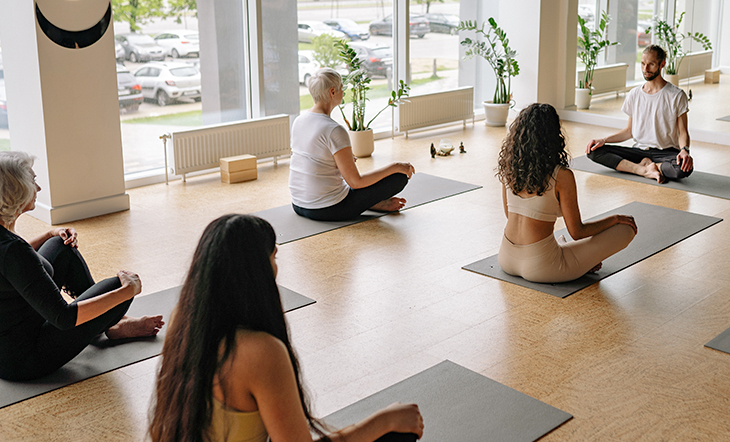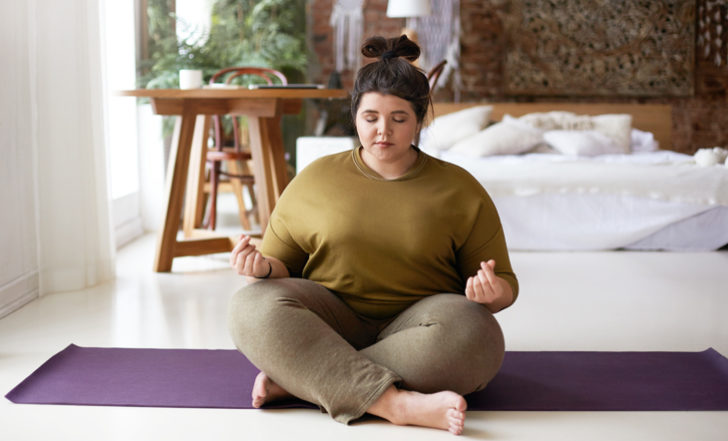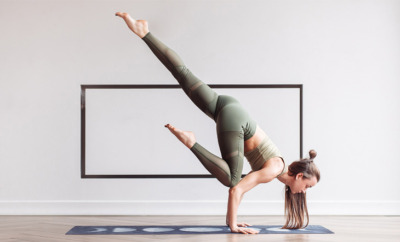Yoga Teachers: You Might Want to Re-Evaluate These 6 Yoga Cues

One mark of a truly great yoga teacher is excellent cueing. Creative yoga cues can connect the dots for students in new ways, even if they’ve been practicing yoga for years.
It’s easy, when we’re new to teaching yoga, to echo what we’ve heard our teachers say when getting students into and out of postures. If we’ve been teaching yoga for a long time, we can cruise in auto-pilot through many of our cues for yoga poses.
Cueing takes practice.
Yoga cues that are inappropriate for your students, or outdated with our newer, accessible understanding of the human body, can cause muscular imbalances, pain or shame for our students. They may feel like they aren’t doing the pose “right” or they may not understand what they’re supposed to be doing at all.

6 Yoga Cues to Re-Evaluate in Your Teaching:
Here are a few familiar yoga cues that may be worth re-evaluating in your teaching.
For a limited time, beYogi is offering YouAligned.com readers $30 off your annual premium, dropping the annual cost to $149. Learn more here.
1. “Scoop Your Tailbone”
The reason this yoga cue exists is to create length through the spine, aka protect the low back and encourage muscular support of the core.
However, over “scooping” or “tucking” your tailbone forward can lead to posterior pelvic tilt, when the bowl of the pelvis spills towards the back. This can cause the upper back and shoulders to compensate, ultimately rippling misalignment throughout the body.
Instead of “scooping” or “tucking” your tailbone, a great cue is to imagine a weight like an anchor hanging from your tailbone. This encourages the tailbone down to reduce compression in the low back without risking over-scooping. A great addition is to focus on core recruitment.
“Imagine an anchor hanging from your tailbone and squeeze your lower abdominals like a counterbalance.”
Scooping and tucking aren’t the only confusing yoga cues! “Knit My Ribs?” 6 Often Confusing Yoga Cues Explained
2. Yoga Cues Relating to “Thighs,” “Belly,” “Booty” or Other Common Trauma-Holding Spaces
People are coming to yoga with all sorts of trauma, both physical and emotional. Yoga is an amazing tool to bring awareness back into the body, feel empowered and strong, and open up musculature that may be chronically closed and tight.
While you can’t know what will trigger a trauma reminder, it is of the utmost importance to be sensitive to trauma-holding spaces. Always refer to body parts with awareness and respect, and always offer alternatives to hyper-sexual or vulnerable movements.
Consider more neutral ways to refer to these body parts. “Thighs,” for example, can easily be “upper leg” or a specific muscle group.
When prompting the class to, “Rest both hands on your belly,” you can provide an opportunity for consent and reasoning behind the hands-on cue. Offer, “If it feels okay, bring both hands to rest on your stomach so you can feel your breath.”

3. Passive Yoga Cues
This is one that can be tricky, especially when you’re first starting out. A passive yoga cue can sound like a narrative and takes authority out of the teacher’s voice. Instead of instructing a student to do something, a passive voice suggests something is happening, as if on its own.
Notice when your teachers use indirect yoga cues, and see if you can practice articulating them more simply.
It’s best described in an example. “Reaching your right leg to the sky, inhale, feeling your hands pressing into the mat…” What is reaching the right leg? Are you feeling your hands or pressing them?
An active cue sounds much stronger: “Reach your right leg to the sky, inhale, press your hands into the mat.”
4. “Shine Your Heart”
What does it really mean to “shine” your heart? Flowery language like this is one reason why people may find yoga inaccessible. Always use plain language, or offer plain language with a creative cue.
Shining your heart forward could be more directly described as “Bring your lower shoulder blades together and press your heart forward.”
5. “Let Your Body Completely Relax”
Weight-bearing passive stretches, like Pigeon Pose, can really open up muscles and connective tissue. However, if your student has a tendency to over-stretch, telling them to relax in pigeon may unintentionally create pain for them later.
Instead, make sure the supporting muscles of joints are active or there are props supporting someone who may be prone to over-stretching.
In Pigeon Pose, you may instruct the student to press their legs gently into the floor, which wakes up the muscles surrounding their hips, and then have them relax from there in a supported way.
6. “Feet Together at the Top of Your Mat”
Larger bodies or people with flat feet may feel more supported with some space between their big toes. Not only can balance be an issue, but anatomically, big toes touching may stress the outer legs, knees or hips and cause muscular imbalances throughout the body.
Instead, invite your students to bring their feet close together in a way they feel tall and supported. From there, you may want to draw attention to certain muscles to create the full expression of Tadasana.
Want more cuing inspiration? Here are 10 Effective Yoga Teaching Cues to Empower Your Students
Elevate Your Teaching and Enhance Your Student’s Experience With These New Yoga Cues
The best teachers cue appropriately for the situation and level of their students. Cueing takes practice, so learn what yoga cues feel authentic to your teaching voice and notice when they seem to land especially well.
One great way to craft truthful yoga cues is by experiencing the flow in your own body. The next time you take a class, notice which cues really resonate.
Another great way is to practice saying yoga cues aloud when you are practicing privately. Play around with authentic and new ways to describe the sensations you feel in your body, and notice how your body responds as you speak them.
Ultimately, you want to enhance the experience for the student and ensure they feel safe in their body as they move through the postures. Namaste!
For a limited time, beYogi is offering YouAligned.com readers $30 off your annual premium, dropping the annual cost to $149. Learn more here.


This Month's Letter
From the Editor
Monthly motivation and food for
thought from our founder.





























